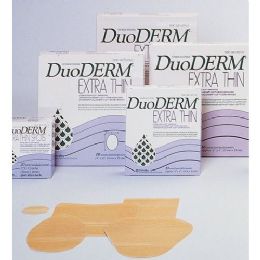
Hydrocolloid dressings are "wafer type" non-breathable, biodegradable, self-adhering opaque synthetic wound dressings containing gel-forming agents intended to promote angiogenesis, fibrinolysis, and wound healing for dry wounds such as superficial lesions, pressure sores, and ulcers.

What are Hydrocolloid Dressings and how do they work?
Hydrocolloid dressings are “wafer type” dressings containing gel-forming agents mixed into an adhesive compound, layered onto a water-resistant and flexible outer layer. They sometimes contain an alginate (insoluble gelatinous carbohydrate found in brown seaweed) to increase absorption capabilities.
The wafers are available with or without an adhesive border, in various thicknesses and precut shapes, and are self-adhering. The precut shapes include square, round, oval, triangular, sacral and butterfly — for ease in dressing odd-shaped areas of the body such as elbows, heels, shoulders and the sacral area. Many are transparent to allow better visualization of wounds, some are odor-preventative, and others include tapered non-roll edges.
The “body side” active surface absorbs moisture from wound exudate, swells, and forms a gel that is held within the structure of the adhesive medium. This produces moist conditions under the dressing that promote wound healing without softening and breaking down tissue. This gel is not free running and mobile, but is held within the adhesive matrix structure.
The part of the dressing touching the undamaged skin surrounding the wound will remain intact until the level of the exudate overwhelms the dressing. When this occurs, the gel will begin to migrate over the intact skin toward the edge of the dressing. This is visible from the top and is a sign that the dressing should be changed.
Hydrocolloid dressings are occlusive, and so provide insulation and autolytic debridement along with a moist healing environment. Autolytic debridement occurs by allowing the dead or damaged tissue to degenerate on its own. The wound remains covered and moist with a hydrocolloid dressing, and may be placed under a compression bandage.
Most are waterproof (allowing normal bathing and washing), and provide a barrier against outside bacteria. It is important to ensure that a wound is free of dirt or external bacteria before applying a hydrocolloid bandage. A clean wound will likely remain free of infection, under this type of covering.
What are examples of the types of wounds for which Hydrocolloid Dressings are used?
Hydrocolloid dressings are not recommended for wounds with heavy exudate, or when infection is present. They must be used with caution (and under medical supervision) on the feet of diabetic patients. Dressings require changing every 3 to 7 days, depending on the level of wound exudate and manufacturer guidelines.
Rehabmart is pleased to offer a large selection of superior quality Hydrocolloid Dressing products from renowned manufacturers that include Independence Medical, McKesson Medical Surgical, North Coast, Medline and other fine manufacturers.
Hulet Smith, OT
Rehabmart Co-Founder & CEO
nrb